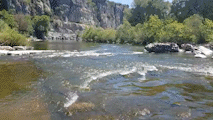A screenplay, or script, is a written work by screenwriters for a film, television program, or video game. These screenplays can be original works or adaptations from existing pieces of writing. In them, the movement, actions, expression and dialogues of the characters are also narrated. A screenplay written for television is also known as a teleplay.
The format is structured so that one page equates to roughly one minute of screen time, though this is only used as a ballpark estimate and often bears little resemblance to the running time of the final movie. The standard font is 12 point, 10 pitch Courier Typeface.
The major components are action (sometimes called "screen direction") and dialogue. The action is written in the present tense and is limited to what can be heard or seen by the audience, for example descriptions of settings, character movements, or sound effects. The dialogue is the words the characters speak, and is written in a center colum
















































